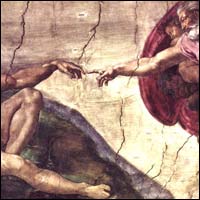
On November first of the year 1512, the ceiling of the Sistine Chapel, painted by Michelangelo, was exhibited to the public for the first time.
In 1508 Michelangelo was commissioned by Pope Julius II to paint the vault, or ceiling of the chapel. It took him until 1512 to complete. To be able to reach the ceiling, Michelangelo needed a support; the first idea was by Bramante, who wanted to build for him a special scaffold, suspended in the air with ropes. But Michelangelo suspected that this would leave holes in the ceiling once the work was ended, so he built a scaffold of his own, a flat wooden platform on brackets built out from holes in the wall, high up near the top of the windows. He stood on this scaffolding while he painted.
The first layer of plaster began to grow mold because it was too wet. Michelangelo had to remove it and start again, but he tried a new mixture, called intonaco, created by one of his assistants, Jacopo l’Indaco. This one not only resisted mold, but also entered the Italian building tradition (and is still now in use). Michelangelo used bright colors, easily visible from the floor.
On the lowest part of the ceiling he painted the ancestors of Christ. Above this he alternated male and female prophets, with Jonah over the altar. On the highest section Michelangelo painted nine stories from the Book of Genesis.
Michelangelo was employed to paint only 12 figures, the Apostles, but when the work was finished there were more than 300. His figures showed the creation, Adam and Eve in the Garden of Eden and the Great Flood. The sketches are a really precious and curious document. Michelangelo used male models, even for the females, because female models were more rare and costly than male ones. (via Wikipedia)
No tags for this post.











